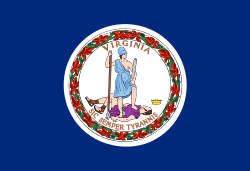Fluvanna Artillery
| Fluvanna Artillery | |
|---|---|
|
Flag of Virginia | |
| Active | May 20, 1861 to June 22, 1865 |
| Country | Confederate States of America |
| Allegiance | Confederate |
| Branch | Army |
| Type | Artillery |
| Size | Battery of four field guns |
| Nickname(s) | "Sons of Fluvanna" |
| Stars and Bars |
.svg.png) |
| Equipment | M1857 12-pound Napoleon, M1841 6-pounder, 3-inch rifled gun |
| Engagements | American Civil War: First Manassas, Peninsula Campaign, Maryland Campaign, Shepherdstown, Overland Campaign, Battle of Gettysburg, Monocacy, Cedar Creek, Waynesboro |
| Commanders | |
| 1st | Captain Charles Huckstep |
| 2nd | Captain John L. Massie |
| 3rd and final | Captain Charles G. Snead |
| Insignia | |
| Army of Northern Virginia Battle Flag |
 |
The Fluvanna Artillery was an artillery battery formed from citizens of Fluvanna County, Virginia, during the American Civil War. It participated in the Antietam and Gettysburg Campaigns, as well as the Shenandoah Valley Campaigns of 1864 under Confederate Major General Jubal Early.
With the outbreak of hostilities following the Battle of Fort Sumter, Governor John Letcher ordered that units be raised from around Virginia and sent to Richmond in order to defend the commonwealth. Fluvanna County was quick to respond to the governor's calls, and organized an artillery battery, the "Sons of Fluvanna," on May 20, 1861, under the command of Capt. Charles Huckstep. With no guns or horses due to local shortages, the battery trained locally until it was ordered to report to Richmond on June 18. It boarded boats on the James River and Kanawha Canal for the trip to Richmond, whereupon arrival, the men were sent to Richmond College for more training and drill. There, the battery finally received its cannons, equipage and horses.
On September 3, cheered by local women as they departed, the Sons of Fluvanna (designated as the 1st Fluvanna Artillery) moved from Richmond to join the main Confederate Army at the First Battle of Manassas. They served in the 1862 Peninsula Campaign with distinction, but were held in reserve at the Second Battle of Manassas and at Sharpsburg. The battery lost a gun and a caisson at the Battle of Shepherdstown covering Robert E. Lee's retreat. In October, the battery was integrated with the "Fluvanna Light Artillery" (or 2nd Battery) into the Fluvanna Consolidated Artillery. The battery saw considerable action during the 1864 Overland Campaign under Capt. John L. Massie, serving from the Wilderness to Cold Harbor.
Transferred as part of Jubal Early's command to the Army of the Valley, the battery participated in Early's raid on Washington, fighting in numerous engagements, including Monocacy and Cedar Creek. Captain Massie was mortally wounded in September 1864, and Capt. Charles G. Snead led the remaining artillerymen for the balance of the war. The unit became defunct, along with the rest of the Army of the Valley, after their capture at the close of the Battle of Waynesboro, Virginia on March 2, 1865. After capture, they were marched to Stephensons Depot. They were then loaded onto box cars and shipped north to Baltimore, Maryland. Their final destination was Fort Delaware Prison. Members were paroled and released between June 21 and 22, 1865.
References
- Martin, David G., The Fluvanna Artillery, Lynchburg, Virginia: The Virginia Regimental Histories Series, H.E. Howard, Inc., 1992. ISBN 1-56190-037-0.
